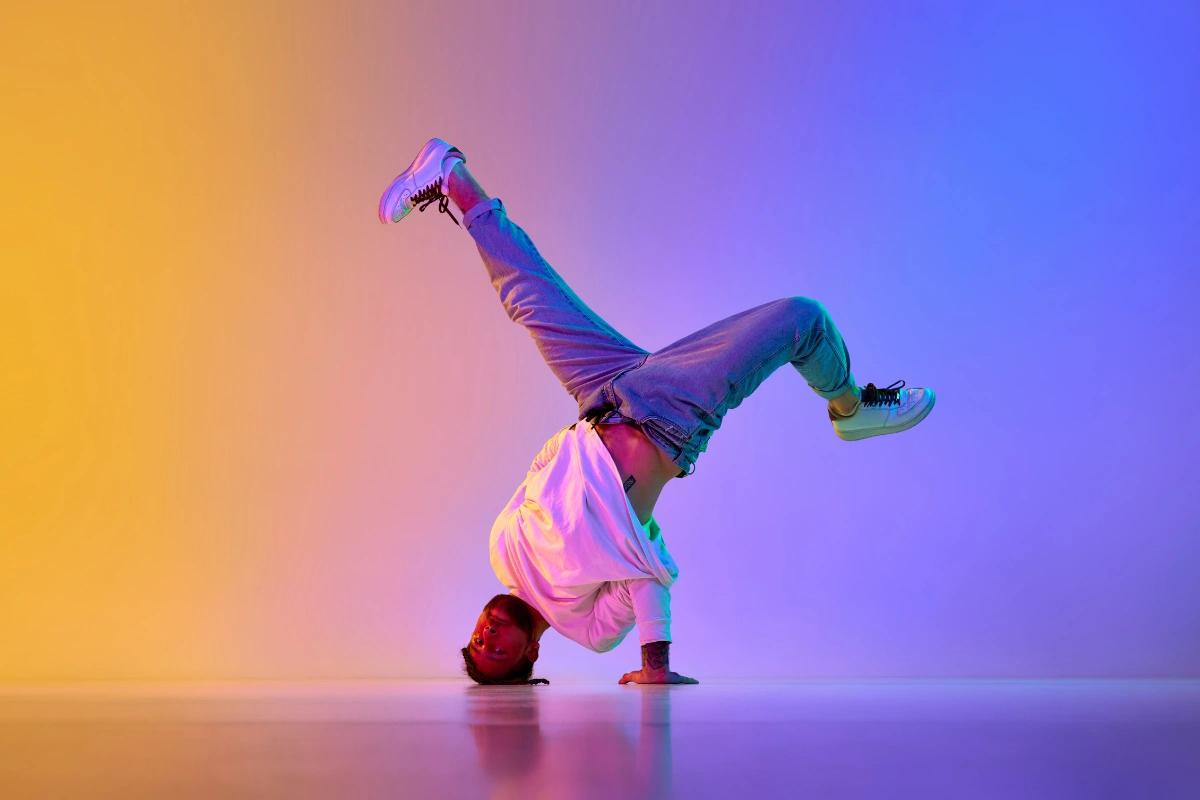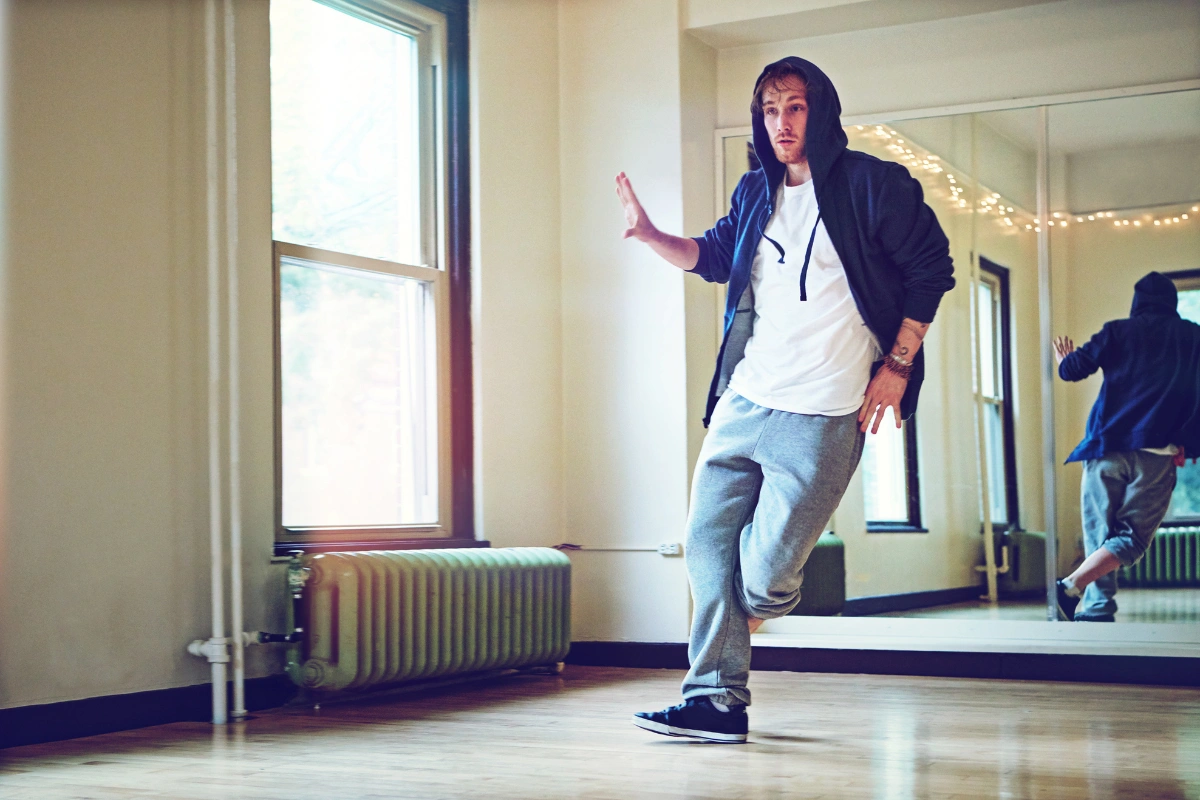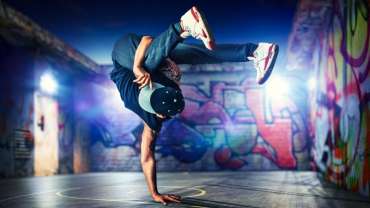Welcome back to our deep dive into the thrilling world of breakdancing with “Power Moves in Breakdance (Part 2).” In the first part, we explored the foundational techniques and iconic maneuvers that define breakdancing’s dynamic nature. Now, we venture further into the realm of advanced power moves that push the limits of physical capability and creativity.
This segment will cover a variety of high-impact moves, including the elusive airchair spin, the mesmerizing halo, and the intricate elbow spin. Each of these power moves not only demands exceptional strength and coordination but also highlights the breakdancer’s ability to innovate and elevate their performance to new heights.
Join us as we continue to celebrate the artistry and athleticism of breakdancing, uncovering the secrets behind these breathtaking maneuvers. Whether you’re an aspiring dancer or a fan of the culture, “Power Moves in Breakdance (Part 2)” promises to inspire and captivate with its exploration of the most advanced and awe-inspiring movements in breakdance.

The halo
The halo is a distinctive power move in breakdancing that blends elements of the baby freeze—a foundational freeze—with a twist involving the head. Named after the halo often depicted above angels’ heads, this move involves a circular motion around the dancer’s head, creating a visually striking effect. Mastering the halo requires precise control, strength, and agility, making it a challenging yet impressive addition to a dancer’s repertoire.
To execute the halo, the dancer begins in a baby freeze position, where they balance on one arm with their legs bent and tucked close to their body. From this stable position, they initiate the movement by using their legs to generate momentum. The dancer then pushes off towards the side of their head, simultaneously twisting their upper body and releasing their hands from the floor.
As the dancer twists their head over the floor, they maintain the rotation and aim to land back in a baby freeze position. The key to achieving a seamless halo is the continuous rotation of this twist around the head, creating a halo-like effect. This circular motion requires coordination between the legs, core, and upper body to maintain balance and control throughout the movement.
A variation of the halo is known as the shoulder halo. In this variation, the dancer starts from a shoulder freeze position instead of a baby freeze. They lean on their shoulders with their legs extended upwards and their head resting on the ground. From this stable base, the dancer pushes off their shoulders into the floor, initiating a rotation of the upper body. The goal is to land back on the shoulder freeze position, maintaining balance and fluidity in the movement.
Both versions of the halo—whether starting from a baby freeze or a shoulder freeze—showcase the dancer’s creativity and technical skill. They require strength in the arms, shoulders, and core, as well as flexibility and precise timing to execute the rotations smoothly.
In conclusion, the halo is a captivating power move in breakdancing that combines elements of freezes with dynamic circular motions around the head. Named after the halo seen above angels, this move exemplifies the artistry and athleticism of breakdancers. Whether performed from a baby freeze or a shoulder freeze, the halo adds a unique flair to breakdancing routines, showcasing the dancer’s ability to innovate and push the boundaries of movement.
The flare
The flare stands as a foundational air power move in breakdancing, characterized by the rhythmic swinging of the legs through the air while balancing the torso between the arms. This dynamic maneuver not only demonstrates agility and strength but also serves as a stepping stone towards mastering more advanced techniques like the airflare.
Originating from gymnastics, the flare was initially known as the Thomas Flair, named after Kurt Thomas, a pioneering gymnast of the 1970s. Thomas first showcased this move on the pommel horse in 1975 before adapting it to floor exercises in 1978. The flare’s evolution continued into the 1980s with Emil Hafner’s contributions, further refining its execution and style.
In its original gymnastic form, the flare emphasized a circular motion, highlighting continuous rotation and momentum. However, breakdancers have reinterpreted the flare, commonly performing it facing one direction with distinct stylistic variations. This adaptation reflects the creativity and innovation within the breakdancing community, blending athleticism with artistic expression.
To execute the flare, the dancer begins by supporting their upper body with their arms while initiating a wide, sweeping motion with their legs. The goal is to maintain balance and fluidity throughout each swing, requiring robust upper body strength, particularly in the arms and shoulders. Core stability is crucial to control the movement’s rhythm and transitions seamlessly between swings.
A notable variation of the flare is the elbow airflare, performed from a handstand position on the forearms. This variation adds complexity by altering the base of support while retaining the fundamental swinging motion characteristic of the flare. Mastery of these variations not only enhances technical proficiency but also expands the dancer’s repertoire of dynamic movements.
In conclusion, the flare exemplifies the evolution of movement from gymnastics to breakdancing, showcasing athleticism and artistic interpretation. As a foundational air power move, it provides a solid framework for exploring advanced techniques within the breakdancing discipline. By mastering the flare and its variations, dancers honor its origins while pushing the boundaries of creativity and innovation in their performances.

1990s and 2000s
The 1990 and 2000 are iconic handstand spinning moves in breakdancing, each showcasing unique techniques and styles that captivate audiences with their dynamic rotations and balance.
The 1990
The 1990 is characterized by the dancer spinning on the palm of their hand while in a one-armed handstand position. This move requires exceptional upper body strength and core stability to maintain balance while rotating around the vertical axis. The dancer’s body twists gracefully, creating a fluid motion as they glide on the palm of their hand. The 1990 is not only a display of physical prowess but also a testament to the dancer’s control and precision in executing complex maneuvers.
The 2000
Similar to the 1990, the 2000 features a handstand spinning move, but with a distinctive twist in its execution. In this variation, the dancer grips the wrist of the hand they are spinning on, adding a unique element to the rotational dynamics. This grip enhances stability and control during the spin, allowing the dancer to focus on maintaining momentum and fluidity in their movements. The 2000 showcases a creative adaptation of the handstand spinning concept, demonstrating versatility and innovation within breakdancing techniques.
Both the 1990 and the 2000 exemplify the evolution of handstand spinning moves in breakdancing, highlighting the fusion of athleticism with artistic expression. These moves not only challenge dancers to push their physical limits but also inspire creativity in choreography and performance. Mastering the intricacies of the 1990 and 2000 requires dedication, practice, and a deep understanding of body mechanics, making them iconic representations of breakdancing’s dynamic and evolving nature.

Crickets
Crickets are fundamental power moves in breakdancing, serving as a stepping stone for mastering more advanced techniques like the jackhammer. This dynamic move begins with the dancer in a turtle freeze position, balancing on one arm with their legs tucked close to their body.
To execute crickets, the dancer initiates tiny hops, using these subtle movements to lift their body off the floor while simultaneously rotating in circles. The key to performing crickets lies in the coordinated use of leg kicks and arm movements. The free arm, which is not supporting the body in the abdominal area, plays a crucial role in generating momentum. As the dancer kicks out their legs and pushes off the ground with the free arm, the hand palm twists slightly with each jump. This twisting action allows the dancer to turn gradually with each hop, maintaining a controlled rotation.
Crickets are often regarded as a basic yet essential breakdance move due to their foundational nature. They require precision, balance, and core strength to execute smoothly and rhythmically. Mastering crickets not only enhances a dancer’s technical abilities but also lays the groundwork for exploring more complex power moves.
One notable progression from crickets is the jackhammer, a more advanced variation that builds upon similar principles of balance and rotational movement. By mastering crickets, dancers develop the agility and control necessary to transition seamlessly into higher-level maneuvers, expanding their repertoire and creativity in breakdancing routines.
In conclusion, crickets represent a foundational element in breakdancing, emphasizing agility, coordination, and rotational control. As dancers refine their skills through practice and dedication, crickets serve as a springboard for exploring the dynamic possibilities within breakdance culture, enriching performances with their rhythmic and expressive movements.
Jackhammer
The jackhammer stands as an advanced power move that builds upon the foundational crickets technique, pushing the boundaries of balance, strength, and control in breakdancing. Unlike crickets, where the dancer uses both arms to assist in jumping and rotating, the jackhammer is performed with remarkable skill and finesse using only one arm for support.
To execute the jackhammer, the dancer begins in a turtle freeze position, balancing on one arm with their legs tucked closely to their body. Initially, they perform crickets to build speed and momentum. As the dancer gains sufficient momentum, they gradually release the supporting arm from the floor, relying solely on the balance and strength of their one-armed turtle freeze.
The hallmark of the jackhammer lies in its ability to sustain continuous hops (small jumps off the floor) and rotational movements without the aid of the other arm. This requires exceptional control and precise timing to maintain stability and rhythm throughout the maneuver. The hand palm twists subtly with each hop, facilitating a smooth and controlled rotation while showcasing the dancer’s mastery of balance and technique.
Witnessing the jackhammer in action is a testament to the dancer’s skill and dedication within the breakdance community. It epitomizes the artistry and athleticism inherent in breakdancing, captivating audiences with its dynamic movements and creative expression.
In summary, the jackhammer represents a pinnacle of achievement in breakdancing, blending technical proficiency with artistic flair. By transcending the foundational crickets move and mastering the complexities of one-armed balance and rotation, dancers elevate their performances and push the boundaries of what is possible within the realm of power moves. As a celebrated maneuver in breakdance culture, the jackhammer continues to inspire and awe, demonstrating the limitless potential of human movement and creativity.

Elbow spin
The elbow spin is an advanced power move that evolves from mastering the elbow or handstand freeze, demonstrating exceptional balance and rotational control in breakdancing. To execute this dynamic maneuver, the dancer begins by transitioning from a standing position to a handstand, carefully swinging each leg into the air and stabilizing on one forearm.
In the initial setup, the dancer maintains a vertical axis, with legs extended in a straight line above the body to optimize balance and stability. The goal of the elbow spin is to achieve as many rotations as possible while maintaining control and fluidity in movement. To enhance rotation speed, the dancer may utilize their free arm or hand to push off the ground, facilitating additional rounds on the supporting forearm.
Mastering the elbow spin requires precise coordination, core strength, and upper body endurance. It exemplifies the technical prowess and creativity within breakdancing, blending athleticism with artistic expression. The ability to spin smoothly and consistently on the forearm showcases the dancer’s dedication to mastering intricate maneuvers that captivate audiences and push the boundaries of physicality.
As a celebrated power move in breakdance culture, the elbow spin highlights the evolution of movement and innovation among dancers. It serves as a testament to the continuous exploration and refinement of techniques, enriching performances with its dynamic and visually captivating rotations.
In summary, the elbow spin stands as a testament to the technical skill and creativity within breakdancing, requiring mastery of balance, strength, and rotational control. By pushing the limits of what is possible on the dance floor, dancers inspire and awe with their ability to transform movement into artistry.
Shoulder spin
The shoulder spin represents a dynamic variation in breakdancing, akin to the classic backspin but distinguished by the dancer’s balance on their upper arm and shoulder. This impressive move requires meticulous technique and strength to achieve fluid rotations while maintaining stability.
To initiate the shoulder spin, the dancer begins from a seated position, legs extended in a V-shape. They generate momentum by swinging each leg individually and carefully lowering their back to the floor, transitioning into a controlled rotation. Unlike the backspin, where the dancer supports themselves on their back, the shoulder spin shifts the point of balance to the upper arm and shoulder.
Maintaining balance on the shoulder spin demands precise body alignment and core engagement. The dancer focuses on keeping the legs extended and balanced above the body, creating a visually captivating effect as they rotate. Mastery of this move involves continuous practice to enhance rotational speed and control, showcasing the dancer’s skill in manipulating momentum and weight distribution.
Compared to other power moves, the shoulder spin highlights versatility and creativity in breakdancing techniques. It challenges dancers to explore new ways of utilizing body mechanics and spatial awareness, enhancing the overall complexity and artistic expression of their performances.
In conclusion, the shoulder spin exemplifies the evolution of breakdancing maneuvers, combining athleticism with technical precision. By mastering the intricacies of balance and dynamics, dancers elevate their routines with captivating spins and transitions, pushing the boundaries of what is possible in the realm of power moves. As a staple in breakdance culture, the shoulder spin continues to inspire and captivate audiences with its graceful and dynamic execution.
Airchair spin
The airchair spin represents an advanced spin maneuver derived from the airchair freeze in breakdancing, characterized by its dynamic rotational movements and intricate balance techniques. This captivating move showcases the dancer’s ability to combine strength, control, and creativity in their performance.
To execute the airchair spin, the dancer begins from the airchair freeze position, where one hand palm supports the body while the other shoulder stabilizes for balance. From this stable base, the dancer initiates the spin by twisting on the hand palm, leveraging their hip to generate speed and momentum. The shoulder of the free arm, not engaged in stabilizing the airchair freeze, plays a crucial role in maintaining equilibrium throughout the rotation.
Achieving fluidity and precision in the airchair spin requires exceptional core strength and upper body endurance. The dancer must coordinate movements smoothly, ensuring that each rotation enhances the visual impact of the performance. By utilizing their hip and shoulder effectively, dancers can enhance rotational speed and control, creating a mesmerizing effect as they spin.
Compared to other freeze-based spins, the airchair spin stands out for its technical complexity and artistic expression. It challenges dancers to explore new dimensions of movement and balance, pushing the boundaries of what is achievable in breakdancing. Mastery of the airchair spin not only showcases technical proficiency but also highlights the dancer’s ability to innovate and evolve within the dynamic landscape of breakdance culture.
In conclusion, the airchair spin exemplifies the fusion of athleticism and artistry in breakdancing, offering a captivating display of balance, strength, and creative expression. As dancers continue to refine their skills and expand their repertoire, the airchair spin remains a cornerstone of innovation and inspiration within the breakdance community, captivating audiences with its dynamic spins and artistic flair.

Criticals
Criticals represent an extraordinary fusion of the jackhammer and an air twist, showcasing a rare and technically demanding power move in breakdancing. This advanced maneuver begins with the practitioner initiating from a turtle freeze position, leveraging their hands to push off the floor.
To execute criticals, the dancer propels themselves into the air, executing a seamless 360-degree rotation while fully airborne. The body remains lifted off the ground throughout the rotation, demonstrating exceptional control and agility. Upon completing the aerial twist, the dancer lands back into the turtle freeze position with precision and balance.
The essence of criticals lies in its continuous execution, where the dancer repeats the sequence in a circular motion. This rhythmic repetition not only emphasizes the fluidity and continuity of movement but also highlights the dancer’s mastery of timing and spatial awareness.
Mastering criticals requires a combination of strength, coordination, and finesse. The practitioner must maintain core stability and upper body strength to execute powerful pushes and controlled rotations. Each iteration of criticals showcases the dancer’s ability to blend dynamic movements with precise technique, creating a visually stunning and impactful performance.
As a rare and revered power move in breakdance culture, criticals exemplify the evolution of creativity and innovation within the art form. Dancers continually push the boundaries of what is possible, integrating elements from different techniques to create new and captivating maneuvers. Criticals not only captivate audiences with their athleticism and skill but also inspire new generations of dancers to explore and innovate within the dynamic world of breakdancing.
In conclusion, criticals stand as a testament to the artistry and athleticism of breakdancing, combining the elements of the jackhammer and air twist into a mesmerizing display of movement and control. By mastering criticals, dancers elevate their performances, pushing the boundaries of creativity and technical proficiency in pursuit of artistic excellence.
Summary
We continue our exploration of advanced breakdancing techniques that push the boundaries of physical prowess and creativity. This segment delves into high-impact moves such as the airchair spin, halo, and elbow spin, each requiring exceptional strength and coordination. These maneuvers not only demonstrate the dancers’ athleticism but also their innovative spirit. Join us as we uncover the intricacies and artistry behind these breathtaking power moves, celebrating the dynamic and evolving world of breakdance.
Author Profile
Latest entries
 Break DanceOctober 20, 2024Master the Cha-Cha Slide
Break DanceOctober 20, 2024Master the Cha-Cha Slide Break DanceOctober 20, 2024The Ultimate Guide to Disco Dance
Break DanceOctober 20, 2024The Ultimate Guide to Disco Dance Break DanceOctober 20, 2024The Role of Creativity in the Sportification of Breakdance
Break DanceOctober 20, 2024The Role of Creativity in the Sportification of Breakdance Break DanceOctober 20, 202412 Popular Dance Styles
Break DanceOctober 20, 202412 Popular Dance Styles






Leave a reply